Abstract
BACKGROUND--It has previously been reported that short term submental stimulation can reduce the frequency of apnoea and improve sleep architecture in patients with obstructive sleep apnoea. The effects of submental stimulation during consecutive nights on apnoea or on daytime sleepiness have not, however, been studied. METHODS--Patients with obstructive sleep apnoea were studied by polysomnography on a control night, for five consecutive nights of submental stimulation, and on three following nights (n = 8). A multiple sleep latency test (MSLT) (n = 8) and measurement of the upper airway resistance (n = 5) were performed during the day after the polysomnographic study, on the control night, and on the fifth stimulation night. In an additional five patients with obstructive sleep apnoea, matched for age, sex, and weight, the effects of two nights of stimulation were examined for comparison. Submental stimulation began when an apnoea lasted for five seconds and stopped with the resumption of breathing as detected by oronasal flow. RESULTS--The apnoea index, the number of times per hour that SaO2 dropped below 85% (SaO2 < 85%/hour), and the total apnoea duration expressed as a percentage of total sleep time during stimulation nights decreased to approximately 50% of the corresponding values on the control night. This improvement persisted for at least two nights after the five consecutive stimulation nights, but not after the two consecutive stimulation nights. Sleep architecture and MSLT following the stimulation nights improved but upper airway resistance did not change. CONCLUSIONS--Submental stimulation for five consecutive nights in patients with obstructive sleep apnoea improved the breathing disturbance, sleep quality, and daytime sleepiness. The effect lasted for the following two nights, but did not completely abolish the sleep disordered breathing.
Full text
PDF
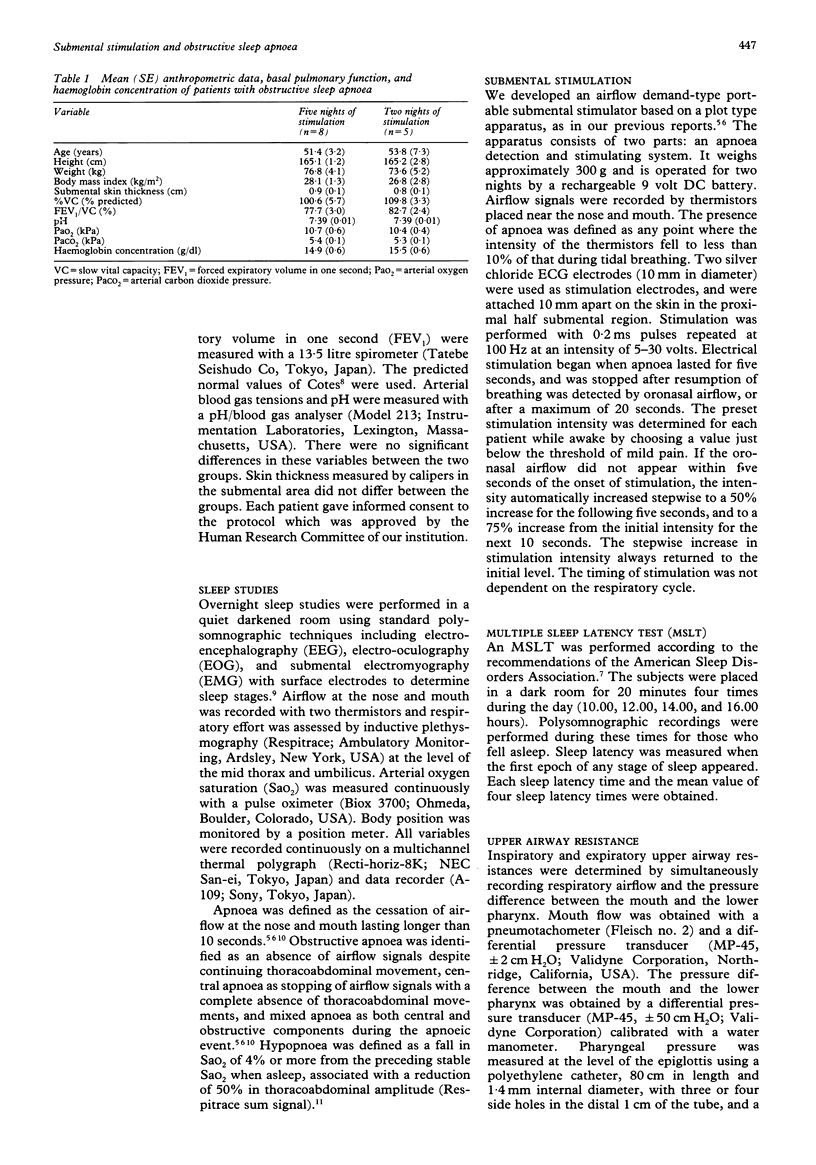
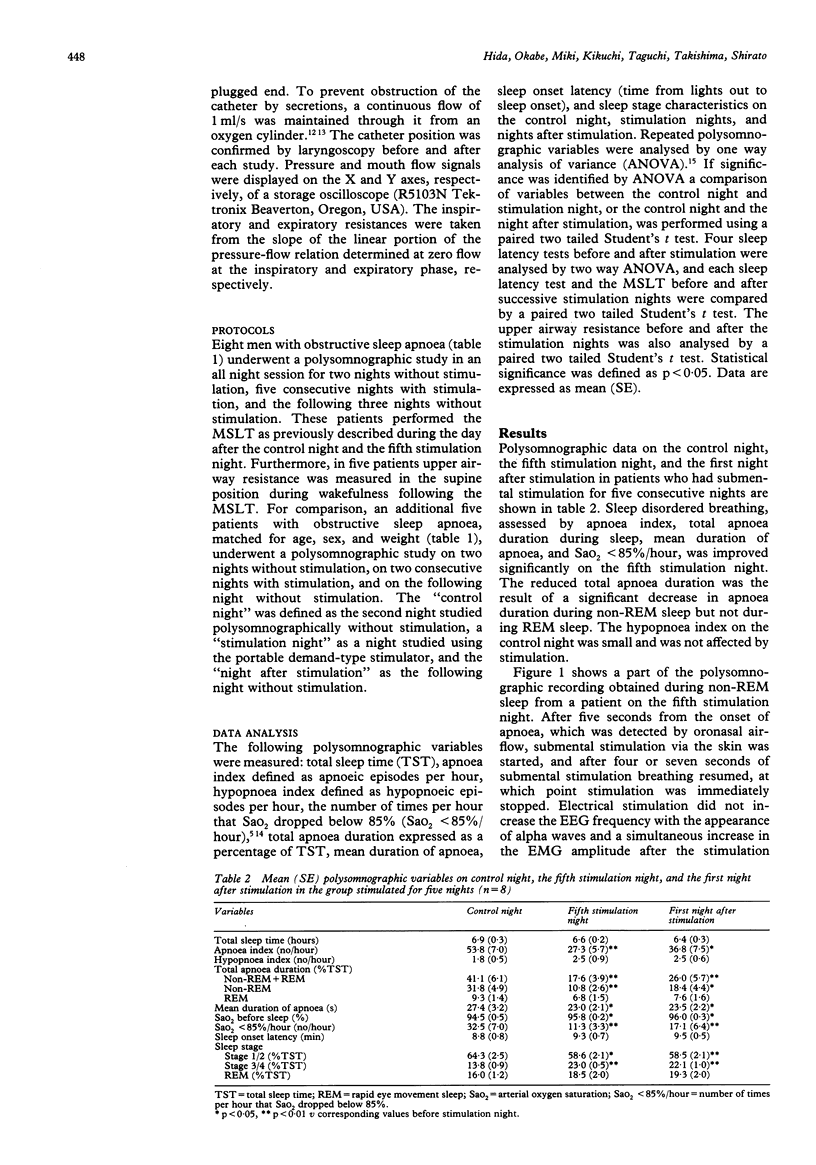

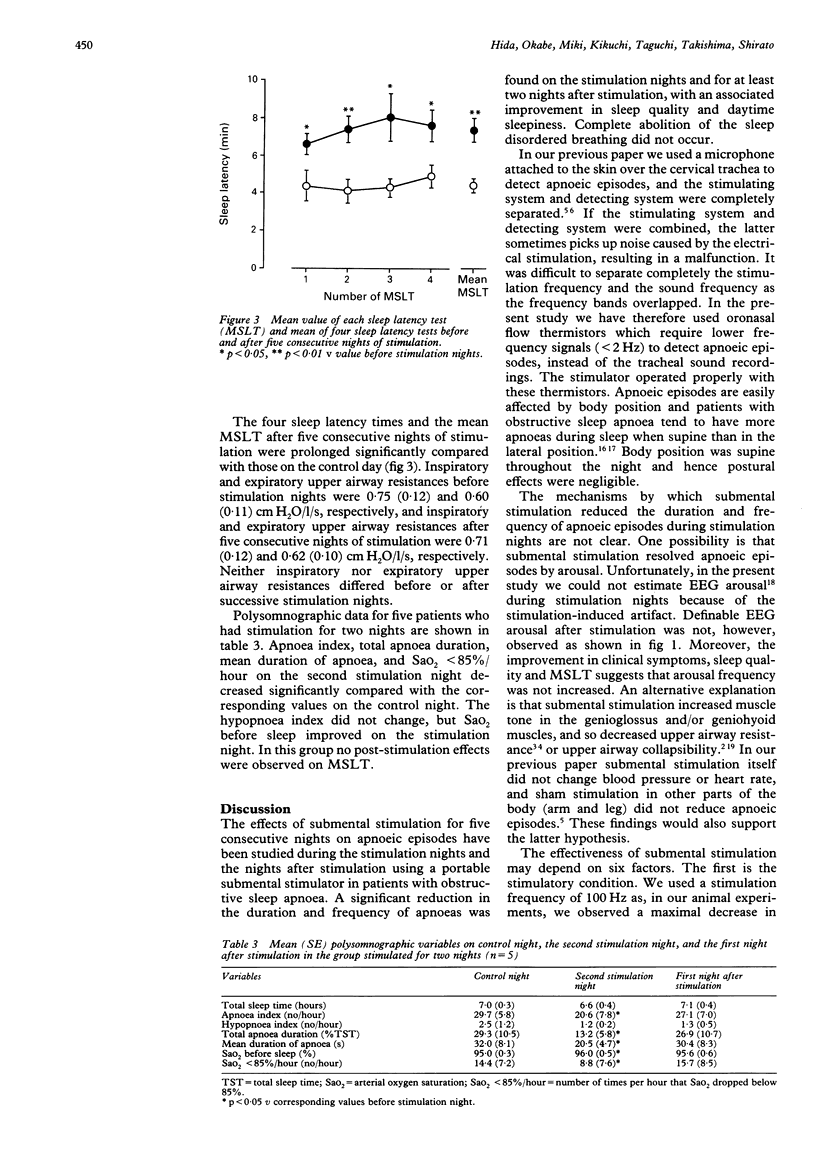
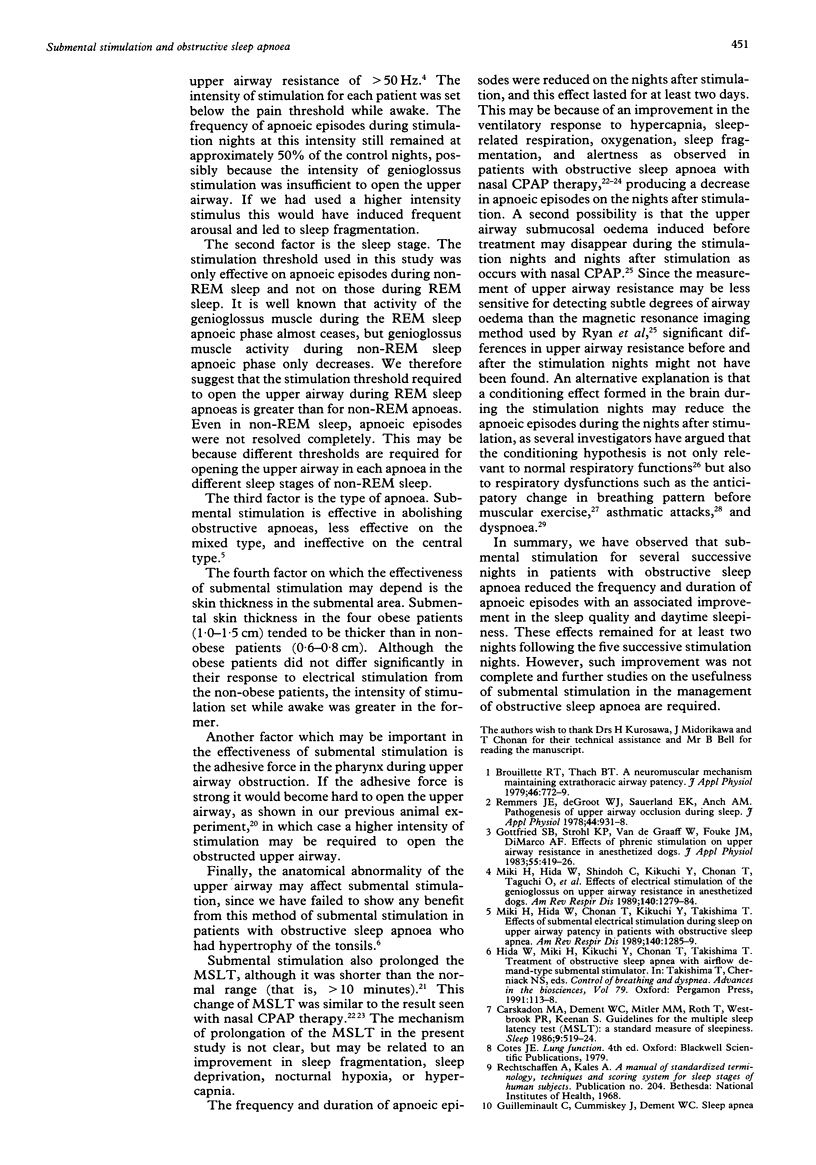
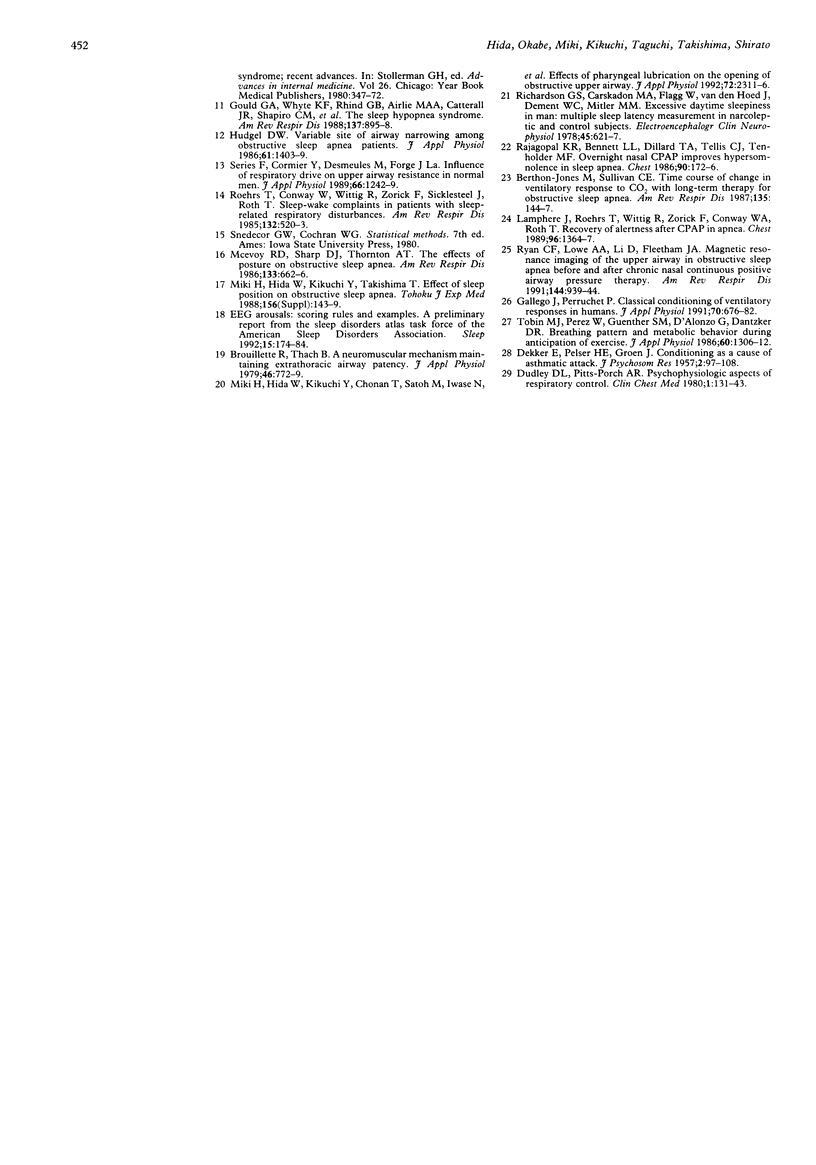
Selected References
These references are in PubMed. This may not be the complete list of references from this article.
- Berthon-Jones M., Sullivan C. E. Time course of change in ventilatory response to CO2 with long-term CPAP therapy for obstructive sleep apnea. Am Rev Respir Dis. 1987 Jan;135(1):144–147. doi: 10.1164/arrd.1987.135.1.144. [DOI] [PubMed] [Google Scholar]
- Brouillette R. T., Thach B. T. A neuromuscular mechanism maintaining extrathoracic airway patency. J Appl Physiol Respir Environ Exerc Physiol. 1979 Apr;46(4):772–779. doi: 10.1152/jappl.1979.46.4.772. [DOI] [PubMed] [Google Scholar]
- Brouillette R. T., Thach B. T. A neuromuscular mechanism maintaining extrathoracic airway patency. J Appl Physiol Respir Environ Exerc Physiol. 1979 Apr;46(4):772–779. doi: 10.1152/jappl.1979.46.4.772. [DOI] [PubMed] [Google Scholar]
- Carskadon M. A., Dement W. C., Mitler M. M., Roth T., Westbrook P. R., Keenan S. Guidelines for the multiple sleep latency test (MSLT): a standard measure of sleepiness. Sleep. 1986 Dec;9(4):519–524. doi: 10.1093/sleep/9.4.519. [DOI] [PubMed] [Google Scholar]
- DEKKER E., PELSER H. E., GROEN J. Conditioning as a cause of asthmatic attacks; a laboratory study. J Psychosom Res. 1957;2(2):97–108. doi: 10.1016/0022-3999(57)90015-6. [DOI] [PubMed] [Google Scholar]
- Dudley D. L., Pitts-Poarch A. R. Psychophysiologic aspects of respiratory control. Clin Chest Med. 1980 Jan;1(1):131–143. [PubMed] [Google Scholar]
- Gallego J., Perruchet P. Classical conditioning of ventilatory responses in humans. J Appl Physiol (1985) 1991 Feb;70(2):676–682. doi: 10.1152/jappl.1991.70.2.676. [DOI] [PubMed] [Google Scholar]
- Gottfried S. B., Strohl K. P., Van de Graaff W., Fouke J. M., DiMarco A. F. Effects of phrenic stimulation on upper airway resistance in anesthetized dogs. J Appl Physiol Respir Environ Exerc Physiol. 1983 Aug;55(2):419–426. doi: 10.1152/jappl.1983.55.2.419. [DOI] [PubMed] [Google Scholar]
- Gould G. A., Whyte K. F., Rhind G. B., Airlie M. A., Catterall J. R., Shapiro C. M., Douglas N. J. The sleep hypopnea syndrome. Am Rev Respir Dis. 1988 Apr;137(4):895–898. doi: 10.1164/ajrccm/137.4.895. [DOI] [PubMed] [Google Scholar]
- Hudgel D. W. Variable site of airway narrowing among obstructive sleep apnea patients. J Appl Physiol (1985) 1986 Oct;61(4):1403–1409. doi: 10.1152/jappl.1986.61.4.1403. [DOI] [PubMed] [Google Scholar]
- Lamphere J., Roehrs T., Wittig R., Zorick F., Conway W. A., Roth T. Recovery of alertness after CPAP in apnea. Chest. 1989 Dec;96(6):1364–1367. doi: 10.1378/chest.96.6.1364. [DOI] [PubMed] [Google Scholar]
- McEvoy R. D., Sharp D. J., Thornton A. T. The effects of posture on obstructive sleep apnea. Am Rev Respir Dis. 1986 Apr;133(4):662–666. doi: 10.1164/arrd.1986.133.4.662. [DOI] [PubMed] [Google Scholar]
- Miki H., Hida W., Chonan T., Kikuchi Y., Takishima T. Effects of submental electrical stimulation during sleep on upper airway patency in patients with obstructive sleep apnea. Am Rev Respir Dis. 1989 Nov;140(5):1285–1289. doi: 10.1164/ajrccm/140.5.1285. [DOI] [PubMed] [Google Scholar]
- Miki H., Hida W., Kikuchi Y., Takishima T. Effect of sleep position on obstructive sleep apnea. Tohoku J Exp Med. 1988 Dec;156 (Suppl):143–149. doi: 10.1620/tjem.156.suppl_143. [DOI] [PubMed] [Google Scholar]
- Miki H., Hida W., Shindoh C., Kikuchi Y., Chonan T., Taguchi O., Inoue H., Takishima T. Effects of electrical stimulation of the genioglossus on upper airway resistance in anesthetized dogs. Am Rev Respir Dis. 1989 Nov;140(5):1279–1284. doi: 10.1164/ajrccm/140.5.1279. [DOI] [PubMed] [Google Scholar]
- Panizza J. A., Finucane K. E. Comparison of balloon and transducer catheters for estimating lung elasticity. J Appl Physiol (1985) 1992 Jan;72(1):231–235. doi: 10.1152/jappl.1992.72.1.231. [DOI] [PubMed] [Google Scholar]
- Rajagopal K. R., Bennett L. L., Dillard T. A., Tellis C. J., Tenholder M. F. Overnight nasal CPAP improves hypersomnolence in sleep apnea. Chest. 1986 Aug;90(2):172–176. doi: 10.1378/chest.90.2.172. [DOI] [PubMed] [Google Scholar]
- Remmers J. E., deGroot W. J., Sauerland E. K., Anch A. M. Pathogenesis of upper airway occlusion during sleep. J Appl Physiol Respir Environ Exerc Physiol. 1978 Jun;44(6):931–938. doi: 10.1152/jappl.1978.44.6.931. [DOI] [PubMed] [Google Scholar]
- Richardson G. S., Carskadon M. A., Flagg W., Van den Hoed J., Dement W. C., Mitler M. M. Excessive daytime sleepiness in man: multiple sleep latency measurement in narcoleptic and control subjects. Electroencephalogr Clin Neurophysiol. 1978 Nov;45(5):621–627. doi: 10.1016/0013-4694(78)90162-1. [DOI] [PMC free article] [PubMed] [Google Scholar]
- Roehrs T., Conway W., Wittig R., Zorick F., Sicklesteel J., Roth T. Sleep-wake complaints in patients with sleep-related respiratory disturbances. Am Rev Respir Dis. 1985 Sep;132(3):520–523. doi: 10.1164/arrd.1985.132.3.520. [DOI] [PubMed] [Google Scholar]
- Ryan C. F., Lowe A. A., Li D., Fleetham J. A. Magnetic resonance imaging of the upper airway in obstructive sleep apnea before and after chronic nasal continuous positive airway pressure therapy. Am Rev Respir Dis. 1991 Oct;144(4):939–944. doi: 10.1164/ajrccm/144.4.939. [DOI] [PubMed] [Google Scholar]
- Sériès F., Cormier Y., Desmeules M., La Forge J. Influence of respiratory drive on upper airway resistance in normal men. J Appl Physiol (1985) 1989 Mar;66(3):1242–1249. doi: 10.1152/jappl.1989.66.3.1242. [DOI] [PubMed] [Google Scholar]
- Tobin M. J., Perez W., Guenther S. M., D'Alonzo G., Dantzker D. R. Breathing pattern and metabolic behavior during anticipation of exercise. J Appl Physiol (1985) 1986 Apr;60(4):1306–1312. doi: 10.1152/jappl.1986.60.4.1306. [DOI] [PubMed] [Google Scholar]


